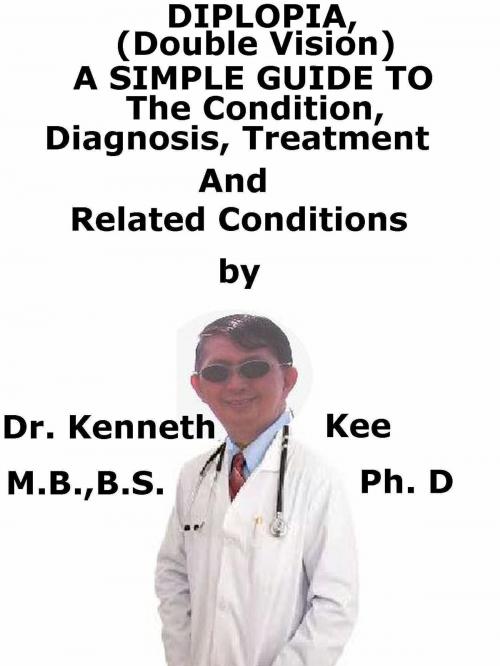Diplopia (Double Vision), A Simple Guide To The Condition, Diagnosis, Treatment And Related Conditions
Nonfiction, Health & Well Being, Health, Ailments & Diseases, Vision, Medical, Specialties, Ophthalmology| Author: | Kenneth Kee | ISBN: | 9781370183173 |
| Publisher: | Kenneth Kee | Publication: | November 5, 2016 |
| Imprint: | Smashwords Edition | Language: | English |
| Author: | Kenneth Kee |
| ISBN: | 9781370183173 |
| Publisher: | Kenneth Kee |
| Publication: | November 5, 2016 |
| Imprint: | Smashwords Edition |
| Language: | English |
Diplopia (double vision) is a medical symptom where a patient sees two images of one object.
Double and blurred vision is frequently believed to be the same but they are not.
In blurred vision, the single image seen by one eye is not clear.
It can either happen as:
1. Monocular diplopia when one eye is covered
In monocular diplopia, possible causes are:
a. Uncorrected refractive errors,
Light from an object is split into two images by a defect in the eye's optical system.
b. Corneal disorders: e.g., warped cornea
c. Cataracts: Cataracts might, for example, cause such a defect.
d. Retinal disorders.
e. Dry eye
2. Binocular diplopia when both eyes are open.
Binocular diplopia develops due to misalignment of the eyes.
Many different causes for double vision begin in the brain:
a. Strokes
b. Aneurysms
c. Raised pressure pressing on the brain from injury, hemorrhage or infection
d. Brain tumors
e. Migraine headaches
Temporary diplopia can be due to alcohol intoxication or head trauma such as concussion.
If temporary double vision does not resolve quickly, an ophthalmologist is seen immediately.
It can also be an adverse effect of:
1. The anti-epileptic drugs Phenytoin and Zonisamide,
2. The anti-convulsant drug Lamotrigine,
3. The hypnotic drug Zolpidem
4. The dissociative drugs Ketamine and Dextromethorphan
Temporary diplopia can also be due to tired and strained eye muscles.
Diplopia also may occur from failure of both eyes to point at the object being observed, a condition referred to as ocular misalignment.
In normal vision, both eyes look at the same object.
The images seen by both eyes are fused into a single picture by the brain.
If the eyes do not point at the same object, the image seen by each eye is not the same and cannot be fused.
This results in double vision.
Double vision that is new or unexplained needs immediate medical attention.
It is important to discover the reason without delay with so many potentially dangerous causes for double vision.
The doctor will most likely use multiple ways to diagnose the cause for double vision.
One of the most effective tools in diagnosing diplopia is the medical history.
The diagnosis of a diplopic patient requires a meticulous history and the posing of questions pertinent to the position of double images in various positions of gaze:
1. The diplopia is monocular or binocular
2. The images are horizontal or vertical
CT scans of the orbit can exclude diplopia secondary to thyroid eye disorder and orbital tumors.
Treatment of double vision is dependent on the underlying cause and may consist of eye patching, prisms, eye exercises, surgical straightening of the eye, or a combination of these options.
Therapy is aimed at realigning the misaligned eye where possible without surgery and re-stimulating the part of the visual system to the brain that is not working correctly.
Certain rare causes of diplopia may be treated with medication
Myasthenia gravis can be treated with medications.
TABLE OF CONTENT
Introduction
Chapter 1 Diplopia (Double Vision)
Chapter 2 Causes
Chapter 3 Symptoms
Chapter 4 Diagnosis
Chapter 5 Treatment
Chapter 6 Prognosis
Chapter 7 Lazy Eye
Chapter 8 Cataract
Epilogue
Diplopia (double vision) is a medical symptom where a patient sees two images of one object.
Double and blurred vision is frequently believed to be the same but they are not.
In blurred vision, the single image seen by one eye is not clear.
It can either happen as:
1. Monocular diplopia when one eye is covered
In monocular diplopia, possible causes are:
a. Uncorrected refractive errors,
Light from an object is split into two images by a defect in the eye's optical system.
b. Corneal disorders: e.g., warped cornea
c. Cataracts: Cataracts might, for example, cause such a defect.
d. Retinal disorders.
e. Dry eye
2. Binocular diplopia when both eyes are open.
Binocular diplopia develops due to misalignment of the eyes.
Many different causes for double vision begin in the brain:
a. Strokes
b. Aneurysms
c. Raised pressure pressing on the brain from injury, hemorrhage or infection
d. Brain tumors
e. Migraine headaches
Temporary diplopia can be due to alcohol intoxication or head trauma such as concussion.
If temporary double vision does not resolve quickly, an ophthalmologist is seen immediately.
It can also be an adverse effect of:
1. The anti-epileptic drugs Phenytoin and Zonisamide,
2. The anti-convulsant drug Lamotrigine,
3. The hypnotic drug Zolpidem
4. The dissociative drugs Ketamine and Dextromethorphan
Temporary diplopia can also be due to tired and strained eye muscles.
Diplopia also may occur from failure of both eyes to point at the object being observed, a condition referred to as ocular misalignment.
In normal vision, both eyes look at the same object.
The images seen by both eyes are fused into a single picture by the brain.
If the eyes do not point at the same object, the image seen by each eye is not the same and cannot be fused.
This results in double vision.
Double vision that is new or unexplained needs immediate medical attention.
It is important to discover the reason without delay with so many potentially dangerous causes for double vision.
The doctor will most likely use multiple ways to diagnose the cause for double vision.
One of the most effective tools in diagnosing diplopia is the medical history.
The diagnosis of a diplopic patient requires a meticulous history and the posing of questions pertinent to the position of double images in various positions of gaze:
1. The diplopia is monocular or binocular
2. The images are horizontal or vertical
CT scans of the orbit can exclude diplopia secondary to thyroid eye disorder and orbital tumors.
Treatment of double vision is dependent on the underlying cause and may consist of eye patching, prisms, eye exercises, surgical straightening of the eye, or a combination of these options.
Therapy is aimed at realigning the misaligned eye where possible without surgery and re-stimulating the part of the visual system to the brain that is not working correctly.
Certain rare causes of diplopia may be treated with medication
Myasthenia gravis can be treated with medications.
TABLE OF CONTENT
Introduction
Chapter 1 Diplopia (Double Vision)
Chapter 2 Causes
Chapter 3 Symptoms
Chapter 4 Diagnosis
Chapter 5 Treatment
Chapter 6 Prognosis
Chapter 7 Lazy Eye
Chapter 8 Cataract
Epilogue















